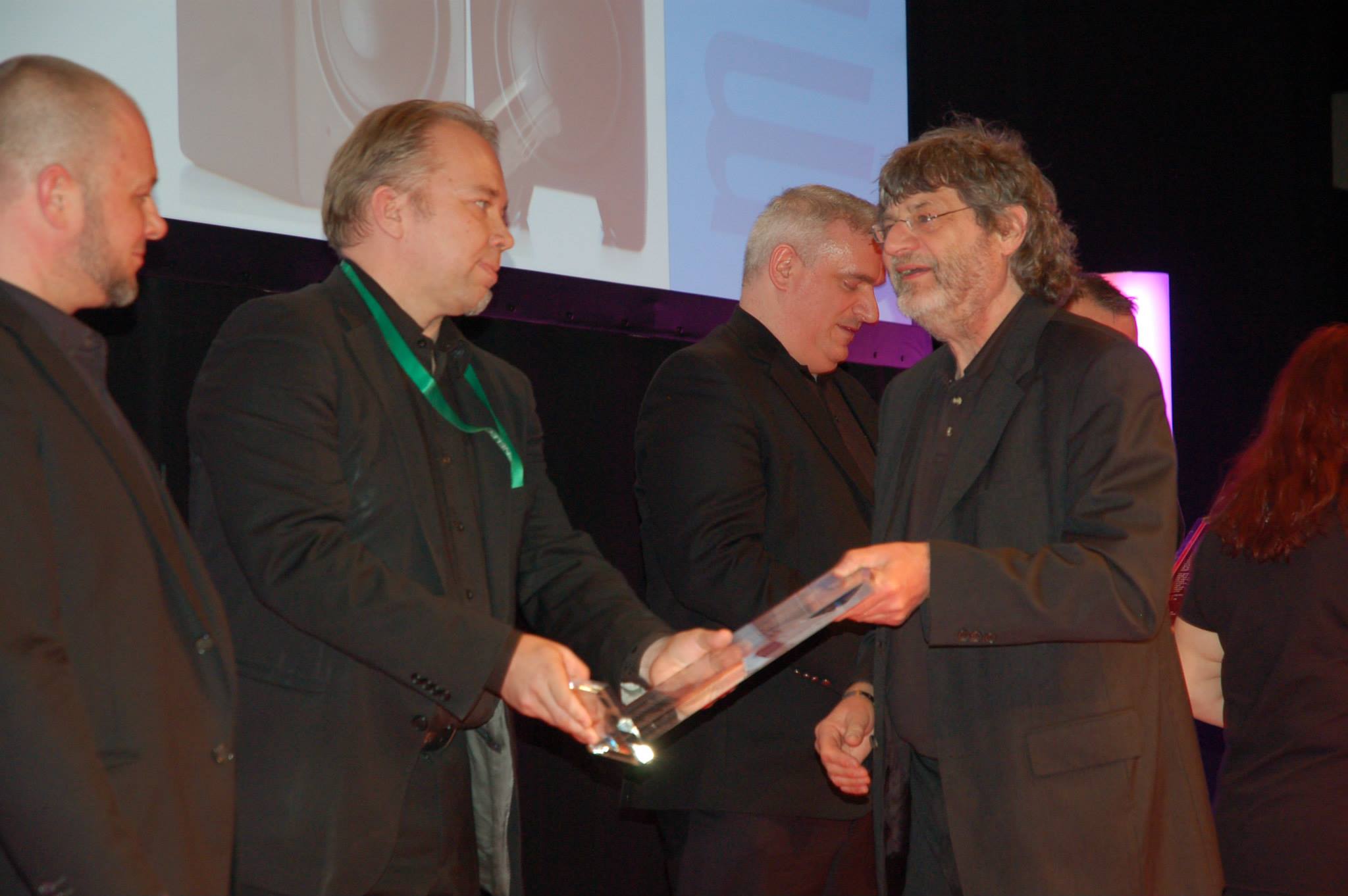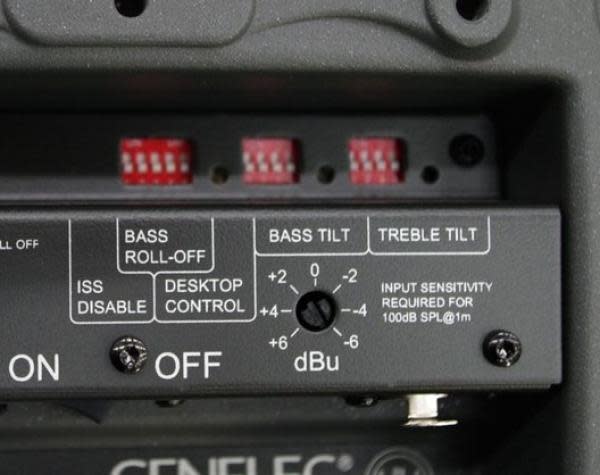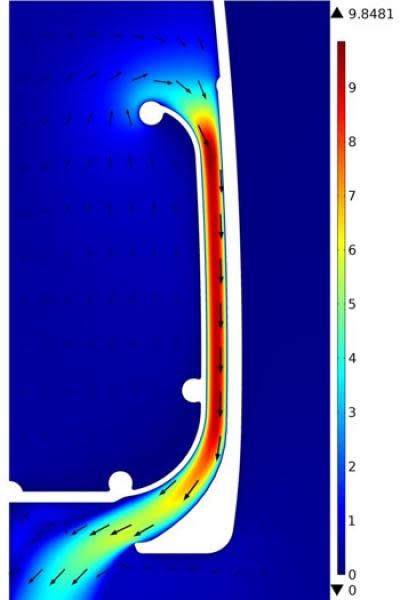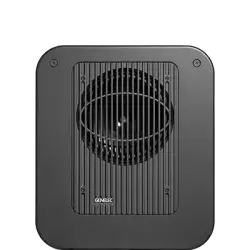M040 Studio Monitor
Awards

Audio Media Gear of the Year 2013 - Outstanding & Innovative Product
Genelec M Series was awarded with the Audio Media Gear of the Year 2013 award in the category "Outstanding & Innovative Product".
KEYS Magazin Leser-Award 2015 - Best Studio Monitors
Genelec M Series was awarded with the KEYS Magazin Leser-Award 2015 in the category "Best Studio Monitors".

PAR Excellence Award 2013
Genelec M Series was awarded a PAR Excellence Award 2013.

PIPA (Pro Light & Sound International Press Award) 2014
Genelec M Series was awarded with the PIPA Pro Light & Sound International Press Award 2014.
Genelec's Sales Director Mikko Tuomi with Juho Martikainen (on the left) receiving PIPA 2014 award for the M Series monitors, which were successfully shown at musikmesse this year!

SOS (Sound On Sound) Global Readers Award 2014 - Best Monitor of The Year
On the first day of the 2015 NAMM show in Anaheim, California, Genelec was awarded ”Best Monitor of the Year 2014” for its M Series monitors, the M030 and M040 models. The winners of the different awards are nominated from the votes of Sound on Sound magazine readers in Europe, USA and Brazil.

TEC (Technical Excellence and Creativity) Award 2014 - Studio Monitor Technology
Genelec M Series was awarded a TEC (Technical Excellence and Creativity) Award 2014 in the category of Studio Monitor Technology.

SPL
107 dB

Potencia del amplificador
80 W Bass (Class D) + 50 W Treble (Class D)

Respuesta en frecuencia
44 Hz - 21 kHz ("-6 dB")

Precisión de la respuesta en frecuencia
± 3 dB (48 Hz - 20 kHz)

Dimensiones
H 337 x W 235 x D 229 mm, (ver en pulgadas)

Peso
7.4 kg / 16.3 lb
M040 product specifications
Especificaciones técnicas

Especificaciones del sistema
Respuesta en frecuencia
48 Hz - 20 kHz (± 3 dB)
Corte de graves -6 dB
44 Hz
Corte de agudos -6 dB
21 kHz

SPL
SPL máximo a corto plazo Maximum sound output (Short term sine wave output on axis in half space, averaged 100-3000 Hz at 1 m).
≥107 dB
Ruido propio
Peso
Peso7.4 kg (16.3 lb)
Dimensiones
Altura
337 mm
Anchura
235 mm
Profundidad
229 mm

Recinto
Material del recinto
Wood-Plastic composite
Tipo de recinto
Reflex port
Directividad

Distorsión armónica
Sección de amplificación
Amplificadores
80 W Class D
50 W Class D
Voltaje de la toma eléctrica
100-120VAC / 220-230VAC 50/60Hz
Consumo de potencia
Con ISS activo
≤0.5 W
En reposo
≤10 W
A pleno rendimiento
60 W
Sección de procesado de señal
Variantes de producto
Códigos de producto
Accesorios compatibles
Códigos de producto
Para más detalles técnicos consulte por favor el manual de operación del producto
Documentos
Operating Manual M040 Quick Setup Guide M040 Brochure M Series In-Room Product PerformanceDescargas
Line Drawings (PDF) M040 Line Drawings (DWG) M040 M Series - Technical Article (AudioXpress) M040 - Simulation File (CLF)Reseñas
Recording Magazine (PDF): Genelec M040 Monitors, June 2014 (US) Sound On Sound Magazine: M040 ON TEST, May 2014 (UK) Monitor: Genelec M030, M040 - Berattigat Impulse-kop, March 2013 (SE) STEREO Magazin: Flucht aus dem Regieraum, April 2014 (DE) Recording Magazin: Druck von unten, March 2014 (DE) Sound & Recording Magazin: Testbericht – Genelec M040, December 2013 (DE) MusicTech Magazine: Genelec M Series M030 & M040 review, November 2013 (GB) Music Store magazine: Genelec M040 - Aktivní poslechové monitory, December 2013 (CZ) amazona.de: Genelec M040, aktive Studiomonitore, December 2013 (DE) fairaudio: BTest: Genelec M040 und BMC Audio PureDAC, November 2013 (DE) delamar Magazine (online): Kompakter Nahfeld-Studiomonitor, September 2013 (DE) AudioMedia: The Internetional Buyer´s Guide (PDF), 2013 (UK)"The audio quality of the new M Series dives deeper into the bass end of the pool."
-by Paul Vnuk Jr., the author of the review article
The Recording Magazine's article "Genelec M040 Monitors" was published in June 2014. It is written by Paul Vnuk Jr.
"Genelec's eco-friendly approach to monitor design continues, with the launch of the new flagship M Series speakers."
-Bob Thomas, the author of the review article
The Sound on Sound Magazine's review article was published in May 2014, and it is written by Bob Thomas.
"A great new design that makes Genelecs more affordable without compromising the sound."
-Jon Musgrave, the author of the review article
MusicTech's (GB) article "Genelec M Series Monitors review" is written by Jon Musgrave. It was published in November 2013.
Read the full article here.
"Aktivní poslechové monitory série M od firmy Genelec jsou dalším (aktuálním) dokladem inovativního přístupu společnosti ke konstrukci jakostních reproduktorových soustav."
-Luděk Oravský, the author of the review article
Music Store magazine's (CZ) review "Genelec M040 Aktivní poslechové monitory" in Czech. The review article was published in December 2013.
"„Aktiivinen tarkkailukaiutin“ habe ich heute im Test, die auf den Namen Genelec M040 hören. Das ist Finnisch und bedeutet „Aktiver Zweiwege-Studiomonitor“. Auf diese Lautsprecher war ich im Vorfeld besonders gespannt, da Monitore von Genelec in meinem Tonstudio seit weit mehr als 10 Jahren die Hauptabhöre darstellen."
-Onkel Sigi, the author of the review article
The review article was published online on the amazona.de website in December 2013. It is written by Onkel Sigi.
The review article "Test: Genelec M040 und BMC Audio PureDAC | D/A-Wandler, KH-Verstärker (stationär), Kompaktlautsprecher, Aktivlautsprecher" was published in November 2013. It is in German.
The review article "Test: Genelec M040 und BMC Audio PureDAC | D/A-Wandler, KH-Verstärker (stationär), Kompaktlautsprecher, Aktivlautsprecher" was published in November 2013. It is in German, and it is written by Jochen Reinecke.
"Im Genelec M040 Testbericht auf delamar untersuchen wir, ob das kompakte Abhörgerät des etablierten finnischen Herstellers sein Geld wert ist. Welche Anschlüsse stehen zur Verfügung, wie ist es um die Verarbeitungsqualität bestellt und wie neutral, wie differenziert spielt dieser Aktivlautsprecher auf? Hier findest Du alle Einzelheiten…"
Quelle: www.delamar.de
The delamar Magazine's (DE) review "Genelec M040 Testbericht: Kompakter Nahfeld-Studiomonitor" is available in German and it is written by Von Felix Baarß. It was published on September 2013.

Active Crossovers

Directivity Control Waveguide (DCW™) Technology

Intelligent Signal Sensing (ISS™) Technology

Laminar Integrated Port (LIP™) Technology

Natural Composite Enclosure (NCE™) Technology

Optimised Amplifiers

Protection Circuitry

Room Response Compensation
Active crossover operating at low signal levels.

Audio electronic crossovers allow the audio signal to be split into separate frequency bands that are separately routed to individual power amplifiers, which are then connected to specific transducers optimised for a particular frequency band.
Active crossovers come in both digital and analogue varieties. Genelec digital active crossovers include additional signal processing, such as driver protection, delay, and equalisation.
Genelec analogue active crossover filters contain electronic components that are operated at low signal levels suitable for power amplifier inputs. This is in contrast to passive crossovers that operate at the high signal levels of the power amplifier's outputs, having to handle high currents and, in some cases, high voltages.
In a typical two-way system the active crossover needs two power amplifiers — one for the woofer and one for the tweeter.
The active crossover design offers multiple benefits:
- The frequency response becomes independent of any dynamic changes in the driver's electrical characteristics or the drive level.
- There is increased flexibility and precision for adjusting and fine-tuning each output frequency response for the specific drivers used.
- Each driver has its own signal processing and power amplifier. This isolates each driver from the drive signals handled by the other drivers, reducing inter-modulation distortion and overdriving problems.
- The ability to compensate for sensitivity variations between drivers.
- The possibility to compensate for frequency and phase response anomalies associated with a driver’s characteristics within the intended pass-band.
- The flat frequency response of a high-quality active loudspeaker is a result of the combined effect of the crossover filter response, power amplifier responses and driver responses in a loudspeaker enclosure.
Using the active approach enables frequency response adjustments and optimisation of the full loudspeaker system, placed in various room environments, without expensive external equalisers. The end result is a simpler, more reliable, efficient, consistent and precise active loudspeaker system.
Directivity Control Waveguide (DCW™) for flat on and off-axis response.

A revolutionary approach was taken by Genelec in 1983 with the development of its Directivity Control Waveguide (DCW™). We have developed and refined this technology over more than 30 years to greatly improve the performance of direct radiating multi-way monitors.
The DCW technology shapes the emitted wavefront in a controlled way, allowing predictable tailoring of the directivity (dispersion) pattern. To make the directivity uniform and smooth, the goal is to limit the radiation angle so that the stray radiation is reduced. It results in excellent flatness of the overall frequency response as well as uniform power response. This minimises early reflections and provides a wide and controlled listening area achieving accurate sound reproduction on and off-axis.
Minimised early reflections and controlled, constant directivity have another important advantage: the frequency balance of the room reverberation field is essentially the same as the direct field from the monitors. As a consequence, the monitoring system's performance is less dependent on room acoustic characteristics.
Sound image width and depth, critical components in any listening environment, are important not only for on-axis listening, but also off-axis. This accommodates not only the engineer doing their job, but also others in the listening field, as is so often the case in large control rooms.
DCW™ Technology key benefits:
- Flat on and off-axis response for wider usable listening area.
- Increased direct-to-reflected sound ratio for reduced control room coloration.
- Improved stereo and sound stage imaging.
- Increased drive unit sensitivity up to 6 dB.
- Increased system maximum sound pressure level capacity.
- Decreased drive unit distortion.
- Reduced cabinet edge diffraction.
- Reduced complete system distortion.
Intelligent Signal Sensing (ISS™) for power consumption reduction in stand-by mode.

Introduced early 2013, Genelec’s Intelligent Signal-Sensing technology has been developed to meet with both European Union ErP Directives and Genelec's own ambitious sustainability standards.
The Intelligent Signal Sensing, ISS™ circuitry tracks the signal input of the loudspeaker and detects if it is in use. If the ISS circuit does not find any audio on the input for a period of time, it sets the loudspeaker to a low-power sleep state and the loudspeaker will consume less than 0.5 watts. When an input signal is detected, the loudspeaker immediately turns itself on.
Additionally an ‘ISS Disable’ switch is located on each product’s back plate next to the other room response controls. First, when the mains power switch of the loudspeaker is set to 'ON', the ISS™ auto-start function (low-power sleep state on/off) of the loudspeaker is active.

If this function is not desired, the ISS™ function can be disabled by setting the 'ISS Disable' switch on the back panel to 'ON' position. In this mode, the monitor is only powered on and off using the mains power switch.
Note that the mains power switch will always turn the monitor off completely.
Laminar Integrated Port (LIP™) allows for precise bass reproduction.

Genelec’s choice for vented (or bass reflex) enclosures dates back to 1978 and the first active monitor developed by Genelec, the S30. Research to improve the performance and efficiency of reflex ports has been pursued ever since.
A typical reflex port enclosure features a tube and an opening area. To avoid turbulences in the tube the air flow should not meet any acute angles as this would generate noise, compression, distortion and losses of the total radiated energy. To minimize the air flow speed, both the tube and its cross section have to be large. Often, the outer enclosure dimensions become a limitation, because a long tube will not fit in the available volume anymore.
The M Series features two vent tubes having opening stretching across half of the enclosure depth to address these specific issues. The novel patent-pending Laminar Integral Port, LIP™, has been flow-optimized using computer-based finite element models to achieve low distortion and high efficiency even at very high audio output levels.

The reflex ports are integrated in the NCE enclosure during the moulding process, avoiding the need for separate additional components. The cross-section plot (Figure) demonstrates the efficient flow characteristics of the port. The natural installation orientation of the M Series is vertical and to allow easy placement of the monitor against a wall, the M Series ports opening face downwards, in the space under the monitor.
The novel Laminar Integrated Port, LIP™, bass reflex system provides accurate low frequency response and faithful tonal reproduction characteristics.
Sustainable and recyclable Natural Composite Enclosure (NCE™).

Since its founding Genelec design philosophy has been based on sustainability and environmental values. Genelec is also known for its ability to introduce new and innovative technology. In fact, from 2003 Genelec was involved in university research projects studying the use of wood composites for injection moulding. In 2009 Genelec started a program to develop enclosures containing one half of wood fibres.
Genelec innovative M Series Natural Composite Enclosure, NCE™, employ a new environmentally friendly material manufactured in Finland from wood fibres and other recyclable materials. The NCE™ material is best described as injection-mouldable wood, which contains approximately half wood fibres. Other materials include colour pigments, flame retardants, lubricants, etc., which are all integrated in a polypropylene matrix. Polypropylene is a recyclable material (polymer resin identification code number 5) that features a low melting point ranging between 130 and 170 degrees Celsius. This environmentally attractive polymer has been selected for its resistance and durability, its high internal damping and its resilience against impacts and physical damage.

In terms of manufacturing, the injection moulding process allows design of structures with small wall thicknesses and multiple internal support and bracing to increase the enclosure stiffness. Production of acoustically highly optimized outer shapes and forms become also possible. At the same time the enclosure internal volume is maximized, which is paramount to achieve high acoustic output at low frequencies. The material itself has high internal vibration energy losses which is advantageous in enclosure design, where damping and rigidity is required.
The highly renewable NCE material features also many of the outstanding acoustical properties found in wood fibres, being 100% stiffer than the common ABS plastics typically used in loudspeaker enclosures.
Additionally, the often environmentally hazardous painting has been eliminated from the production process, saving also in transportation and handling. In fact, enclosure front and back parts are manufactured as finished elements, ready for assembly, in factories close to Genelec’s manufacturing plant.
Each transducer is driven by its own optimised amplifier.

Audio electronic crossovers allow to split the audio signal into separate frequency bands that can be separately routed to individual power amplifiers, which are then connected to specific transducers optimised for a particular frequency band.
In a typical 2-way loudspeaker system, the active crossover needs two power amplifiers — one for the woofer and one for the tweeter. The power amplifiers are connected directly to the drivers of an active loudspeaker, resulting in the power amplifier’s load becoming much simpler and well known. Each driver-specific power amplifier has only a limited frequency range to amplify (the power amplifier is placed after the active crossover) and this adds to the ease of design.
The active design principle offers multiple benefits:
- The power amplifiers are directly connected to the speaker drivers, maximising the control exerted by the power amplifier’s damping on the driver’s voice coil, reducing the consequences of dynamic changes in the driver electrical characteristics. This may improve the transient response of the system.
- There is a reduction in the power amplifier output requirement. With no energy lost in the passive crossover filter components, the amplifier power output requirements are reduced considerably (by up to 1/2 in some cases) without any reduction in the acoustic power output of the loudspeaker system. This can reduce costs and increase audio quality and system reliability.
- No loss between amplifier and driver units results in maximum acoustic efficiency.
- Active technology can achieve superior sound output vs. size vs. low frequency cut-off performance.
- All loudspeakers are delivered as a factory aligned system (amplifiers, crossover electronics and enclosure-driver systems).
Sophisticated drive unit protection circuitry for safe operation.

When working in critical audio production environments it is essential that monitoring systems remain reliable and functional at all times. One of the main reasons behind Genelec’s excellent success in broadcasting environments is the reliability of our products and a key element behind the reliability is the internal protection circuitry found in all products since 1978.
The protection circuitry prevents driver failures by detecting signal levels, and in case of sudden peaks or constantly too high levels, taking the signal level down automatically. Of course this feature does not affect the sound quality in any way when working within the specifications of the loudspeaker, but only prevents inadequate input signals from breaking the loudspeaker.

Protection circuitry features and benefits:
- Reduces the output level when required, (e.g. when driver voice coil temperature reaches the safe limit), which highly improves system reliability.
- Appropriate protection circuitry design in every loudspeaker and subwoofer enables the maximisation of system output sound level.
Precise room response compensation for optimizing in-room performance.

The interaction between room acoustic and loudspeaker radiation is complex. Each room changes somewhat the monitor’s response in a unique way, e.g. reflective vs. damped rooms, or placement against a wall vs. on a stand away from the walls.
All Genelec loudspeaker systems feature room response adjustments to compensate for the room influences and retrieve a flat frequency response at the listening position.
Analogue Systems
Genelec analogue loudspeaker systems provide versatile Room Response Controls. They include (depending on models):
- Bass Roll-Off and Bass Tilt
- Treble Tilt and Treble Roll-Off
- Bass Level
- Midrange Level
- Treble Level
- Desktop Control

At low frequencies two main controls are provided. The Bass Tilt control, which acts as a shelving filter together with the Bass Roll-off control allowing you to optimize the low and very low frequency response of the system in different installations. Bass, midrange and treble level controls are provided in large systems. These controls allow to optimize the relative balance between the various pass bands.
The operating manual and datasheet of each loudspeaker contains a list of preferred room response control settings for different installations. These have been specified out of long practical experience and measurements of various kind of typical acoustic environments.
Smart Active Monitor (SAM™) Systems
Genelec SAM Systems offer a comprehensive, solution-oriented, intelligently networked product range which all feature Genelec Loudspeaker Manager (GLM™) software and its automatic calibration system called AutoCal™.
Genelec AutoCal provides the industry’s first integrated process for complete automated measurement, analysis, and adjustment of every monitor on the GLM control network. The system measures the response in the listening area and applies relevant compensation in the low and low-mid frequencies to minimise the detrimental room acoustic anomalies as well as the differences between various listening positions. AutoCal also aligns relative levels, time-of-flight, as well as adjusts correct crossover phase (called AutoPhase) for all subwoofers on the network.

The Acoustic Response Editor provides accurate graphical display of the measured response, filter compensation and the resulting system response for each monitor, with full manual control of acoustic settings.
















